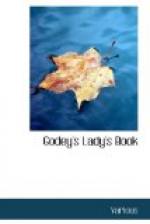[Illustration]
About the beginning of the thirteenth century, the ladies found their long narrow cuffs, hanging to the ground, very uncomfortable; they therefore adopted tight sleeves. Pelisses, trimmed with fur, and loose surcoats, were also worn, as well as wimples, an article of attire worn round the neck under the veil. Embroidered boots and shoes formed, also, part of their wardrobe.
The ladies’ costume, during the reigns of Henry and Edward, was very splendid. The veils and wimples were richly embroidered, and worked in gold; the surcoat and mantle were worn of the richest materials; and the hair was turned up under a gold caul.
[Illustration]
Towards the year 1300, the ladies’ dress fell under the animadversion of the malevolent writers of that day. The robe is represented as having had tight sleeves and a train, over which was worn a surcoat and mantle, with cords and tassels. “The ladies,” says a poet of the thirteenth century, “were like peacocks and magpies; for the pies bear feathers of various colors, which Nature gives them; so the ladies love strange habits, and a variety of ornaments. The pies have long tails, that trail in the mud; so the ladies make their tails a thousand times longer than those of peacocks and pies.”
The pictures of the ladies of that time certainly present us with no very elegant specimens of their fashions. Their gowns or tunics are so immensely long, that the fair dames are obliged to hold them up, to enable them to move; whilst a sweeping train trails after them; and over the head and round the neck is a variety of, or substitute for, the wimple, which is termed a gorget. It enclosed the cheeks and chin, and fell upon the bosom, giving the wearer very much the appearance of suffering from sore-throat or toothache.
When this head-dress was not worn, a caul of net-work, called a crespine, often replaced it, and for many years it continued to be a favorite coiffure.
The writers of this time speak of tight lacing, and of ladies with small waists.
In the next reign, an apron is first met with, tied behind with a ribbon. The sleeves of the robe, and the petticoat, are trimmed with a border of embroidery; rich bracelets are also frequently seen; but, notwithstanding all the splendor of the costume, the gorget still envelops the neck.
* * * * *
SONNET.—WINTER.
BY LEWIS GRAHAM, M.D.
Stern Winter comes with frowns and frosty
smiles,
The angry clouds in stormy
squadrons fly,
While winds, in raging tones,
to winds reply;
Old Boreas reigns, and like a wizard,
piles,
Where’er he pleases,
with his gusty breath,
The heaps of snow on mountain,
hill, or heath,
In strangest shapes, with curious sport
and wild;
But soon the sun will come
with gentle rays,
To kiss him while with fiercest




